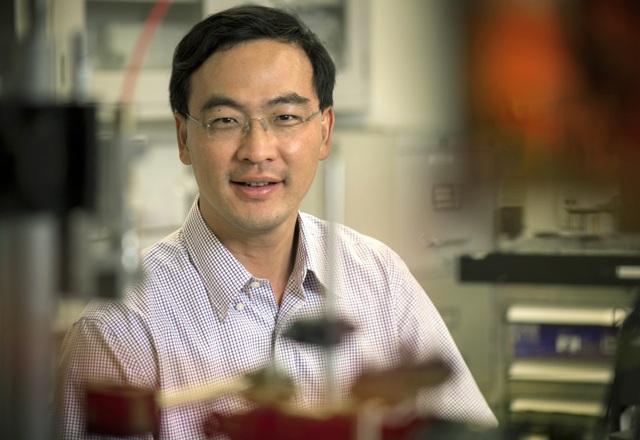Feb 3 2016
A new type of ultra-thin semiconductor laser under development at The University of Texas at Arlington can be integrated with mainstream electronics on the same silicon substrate with increased capacity and energy efficiency.
 Weidong Zhou, UTA electrical engineering professor, is working to develop a new ultrathin semiconductor laser that will increase the chip's speed and capacity
Weidong Zhou, UTA electrical engineering professor, is working to develop a new ultrathin semiconductor laser that will increase the chip's speed and capacity
Weidong Zhou, an electrical engineering professor at UTA, will use a three-year, $600,000 grant from the U.S. Army Research Office to build upon advances made through previous grants he has received for printed photonic crystals and silicon “lab-on-a-chip” technology. Yuze “Alice” Sun, an assistant professor of electrical engineering at UTA, is co-principal investigator.
“Big companies like IBM and Intel are using this technology for high-performance computing centers,” Zhou said. “The big push now is for the next big thing: smaller, faster, and less and less power consumption.”
Zhou also has recently received a three-year, $935,000 grant from the Air Force Office of Scientific Research to explore extreme energy efficiency lasers, in collaboration with Professors Shanhui Fan at Stanford and Xiuling Li at the University of Illinois Urbana-Champaign.
The projects point to an increasingly important role The University of Texas at Arlington is playing in the world of lasers and how they work on semiconductors.
Zhou is a Fellow of the International Society for Optical Engineering. He holds three issued patents related to this technology and has more than 270 journal publications and conference presentations. He joined UTA in 2004 after a brief career in industry.
A paper, entitled, “Printed Large-Area Single-Mode Photonic Crystal Bandedge Surface-Emitting Lasers on Silicon,” was published online last month in Nature’s Scientific Reports. It outlined Zhou’s findings from related research supported by the National Science Foundation, the Air Force Office of Scientific Research and the Army Research Office.
His previous research led to innovations that removed roadblocks to putting optical technology on a silicon chip.
Specifically, Zhou developed a membrane laser less than one micron thick that is compatible with planar Complementary Metal Oxide Silicon platforms, which are the building blocks for all electronics and can be easily integrated with current platforms. The key innovation is the integration of certain compound semiconductor material with a silicon photonic crystal cavity, which allows a laser to be built directly on a silicon chip next to other electrical components. This leads to higher speed and higher efficiency.
The first application of Zhou’s laser is in computers and data centers where higher bandwidth and transfer rates at lower energy outputs are prized. Zhou’s group is actively pursuing various innovative membrane laser architectures for extreme energy efficient computing and communication systems. Zhou and collaborators will use his new grant to continue innovations in high-performance membrane lasers, including the one reported in Nature Photonics in 2012, entitled, “Transfer printing stacked nanomembrane lasers on silicon.”
“We are looking for devices and components to be integrated on a chip,” Zhou said. “As we address electrical injection, integration with other devices on the chip and increased power capabilities, we can begin to apply this technology to products in the medical field or in the consumer arena. These applications could include portable electronics, sensing and imaging equipment, bio applications and wearable electronics.”
Zhou has been the primary investigator on research grants totaling nearly $6 million and has been involved with more than 30 projects totaling more than $18 million since 2004.
The Electrical Engineering Department is an integral component of UTA’s College of Engineering, which recently became the third-largest in Texas with an enrollment of more than 7,000. Other department faculty members working in the field of photonics include National Academy of Inventors Charter Fellow Robert Magnusson and Michael Vasilyev, a Fellow of The Optical Society.
Khosrow Behbehani, dean of the College of Engineering, commended Zhou’s innovations as a model of the University’s work to advance Global Environmental Impact under the Strategic Plan 2020: Bold Solutions | Global Impact.
“As technology becomes pervasive in our everyday life from the cars we drive to our clothing, the ability to make smaller, more power-efficient components becomes more valuable,” said Behbehani. “Dr. Zhou’s research could be truly groundbreaking and lead to many future discoveries.”
About The University of Texas at Arlington
The University of Texas at Arlington is a comprehensive research institution of more than 51,000 students in campus-based and online degree programs and is the second-largest institution in The University of Texas System. The Chronicle of Higher Education ranked UTA as one of the 20 fastest-growing public research universities in the nation in 2014. U.S. News & World Report ranks UTA fifth in the nation for undergraduate diversity. The University is a Hispanic-Serving Institution and is ranked as the top four-year college in Texas for veterans on Military Times’ 2016 Best for Vets list. Visit www.uta.edu to learn more, and find UTA rankings and recognition at http://www.uta.edu/uta/about/rankings.php.